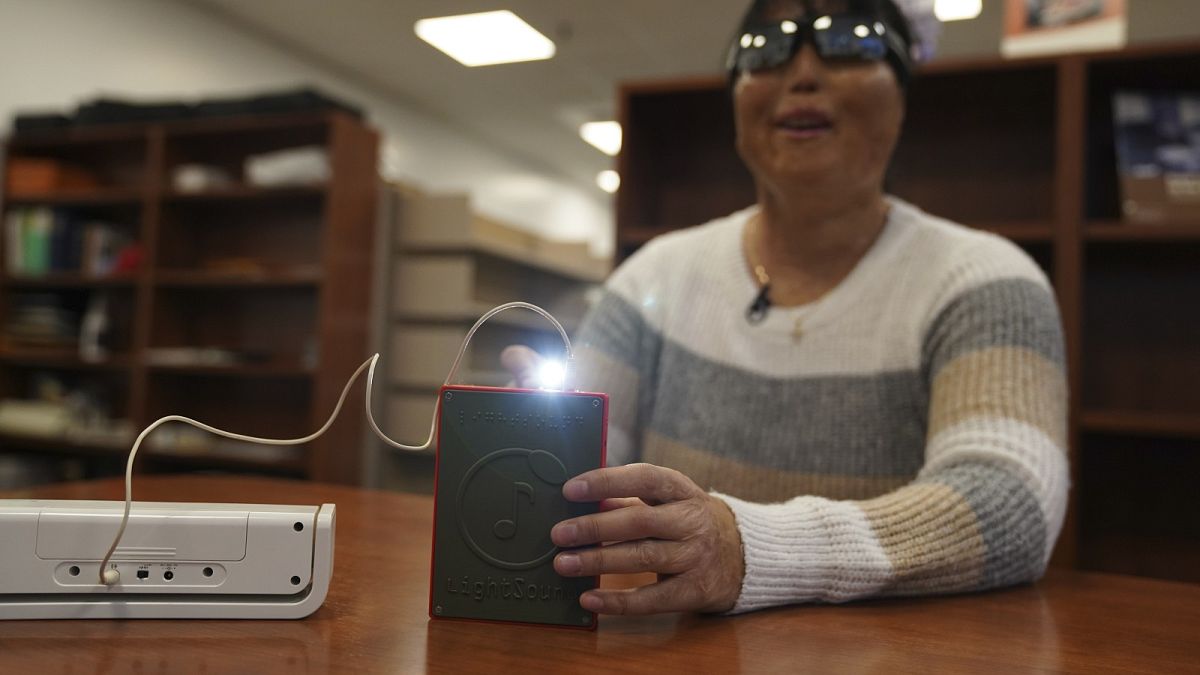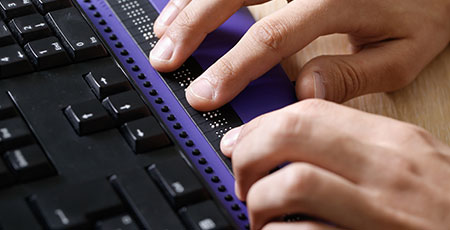Mobility Aids for Visually Impaired Users: Improving Autonomy
Mobility Aids for Visually Impaired Users: Improving Autonomy
Blog Article
Discover Innovative Tools Made for the Aesthetically Damaged
The growth of ingenious devices for the visually damaged represents a substantial advancement in accessibility and freedom. Technologies such as clever glasses with AI capacities and mobile applications made to supply auditory descriptions are improving everyday experiences for users. Additionally, wearable tools that utilize haptic comments boost ecological awareness, while contemporary Braille technologies offer new ways to engage with text. As these tools proceed to progress, their influence on the lives of those with visual problems elevates essential questions regarding the future of inclusivity and freedom in numerous facets of life. What lies ahead in this technological landscape?
Smart Glasses for Navigation

Smart glasses made for navigating are reinventing the method visually damaged individuals engage with their atmosphere. These advanced tools utilize a mix of video camera innovation, fabricated intelligence, and auditory responses to offer real-time info regarding environments. By utilizing barrier detection systems, clever glasses can inform customers to potential threats, enabling much safer wheelchair in both unknown and acquainted settings.
The combination of GPS modern technology even more enhances navigating capabilities, permitting users to obtain auditory directions as they relocate. This hands-free technique not just cultivates independence yet also empowers aesthetically impaired individuals to navigate city landscapes with raised self-confidence. Furthermore, several smart glasses are furnished with functions that determine spots and road indications, offering contextual info that enhances the user experience.
Moreover, the growth of these gadgets is continually advancing, with firms functioning to enhance the accuracy of object acknowledgment and broaden the array of navigational features. As smart glasses come to be much more budget friendly and obtainable, they hold the possible to significantly change day-to-day live for visually impaired users. Eventually, these innovative devices stand for a critical action toward inclusivity, offering boosted wheelchair and a greater sense of autonomy for individuals browsing the world around them.

Mobile Application for Daily Living
Just how can mobile applications boost the every day lives of aesthetically damaged people? Mobile applications are reinventing the means visually impaired individuals browse their environments, handle day-to-day tasks, and accessibility details. These applications provide necessary assistance through different functionalities, promoting freedom and improving lifestyle.
A number of cutting-edge mobile applications are created particularly for everyday living. For instance, apps like Be My Eyes connect visually impaired customers with sighted volunteers by means of video clip phone calls, allowing them to receive real-time support with tasks such as reviewing labels or navigating unknown rooms. Seeing AI, created by Microsoft, utilizes artificial intelligence to describe environments, reviewed text, and recognize items, successfully changing a mobile phone right into an effective tool for daily support.
In addition, navigating apps tailored for the visually damaged, such as Aira and BlindSquare, provide audio-based instructions and environmental info, enabling customers to traverse their surroundings securely and confidently. Past navigation and prompt support, mobile applications also sustain organization and job administration, with attributes that help customers establish suggestions, develop order of business, and track consultations. In summary, mobile applications work as vital resources, encouraging visually damaged individuals to lead more independent and meeting lives.
Wearable Technologies for Support
Empowerment via innovation is increasingly noticeable in the realm of wearable gadgets created to aid visually damaged individuals. These cutting-edge tools incorporate seamlessly right into every day life, improving navigating and providing vital responses to customers. Clever glasses equipped with cams can recognize faces and read message out loud, permitting customers to engage more confidently in professional and social setups.
An additional remarkable development is using haptic feedback systems in wearable gadgets. These systems utilize vibrations or other responsive signals to share details concerning the individual's atmosphere, such as challenges or adjustments in surface, enhancing movement and safety and security. Wearable innovations additionally consist of wristbands that link to smartphones, signaling local optometrist customers to alerts via refined resonances, therefore improving connection without reliance on aesthetic hints.
As these innovations remain to develop, they are not only improving self-reliance for aesthetically damaged people however also cultivating a better sense of incorporation in society. By bridging the void between obstacles encountered in daily living and the possibility for autonomy, wearable innovations work as crucial tools in the pursuit for equal rights and empowerment for those with visual disabilities.
Sound Summary Tools
Audio summary devices play an important duty in enhancing accessibility for visually damaged individuals, giving them with the capability to involve with visual media. Voice-activated assistive devices. These tools supply narrated descriptions of vital visual aspects in movies, television shows, and live performances, making certain that users can completely understand the context and emotions communicated through visuals
Audio summary can be integrated into different systems, including streaming solutions, cinema screenings, and live cinema. Many popular streaming services currently consist of audio summary as an accessibility function, permitting audiences to pick it easily. Along with traditional media, specialized applications also exist, supplying audio descriptions for art events, museums, and various other cultural occasions.
The performance of audio summary rests on the skill of the storytellers, that should convey aesthetic details succinctly without interfering with the initial sound. Technologies in this area are also paving the means for even more customized experiences, where users can readjust the degree of information and pacing according to their preferences.
Braille Innovations and Gadgets
Braille gadgets and technologies have substantially transformed the means aesthetically impaired individuals interact with text and information. Modern improvements have actually resulted in why not check here the development of versatile devices that improve proficiency and independence amongst individuals. Especially, Braille show innovations have actually advanced, allowing for vibrant analysis experiences. These devices transform digital text into Braille, making it possible for individuals to access a large range of info on computer systems, smart devices, and tablet computers.
Additionally, portable Braille notetakers combine standard Braille input with contemporary performances, promoting note-taking, scheduling, and document editing on the go. Wearable technology for low vision. These portable devices commonly feature text-to-speech abilities, bridging the space between Braille and acoustic details
In enhancement, cutting-edge Braille printers have actually arised, permitting individuals to create Braille labels, files, and academic materials efficiently. This ease of access cultivates better engagement in expert and academic environments, eventually advertising inclusivity.
Moreover, study right into wise Braille technologies proceeds to increase. Gadgets that include man-made intelligence are being discovered to supply real-time navigating aid and contextual details, boosting the customer experience in diverse settings. Overall, these innovations reflect a commitment to encouraging visually damaged people with technology, ensuring they can conveniently access and engage with the globe around them.

Conclusion
The improvement of cutting-edge devices for the aesthetically damaged considerably improves freedom and top quality of life. Smart glasses, mobile applications, wearable modern technologies, audio summary tools, and Braille innovations jointly empower people by giving vital navigating aid, environmental recognition, and enhanced reading experiences. These technologies not just foster greater inclusion however also promote autonomy in everyday tasks, inevitably adding to a much more equitable and easily accessible society for visually impaired people. Proceeded development in this field holds pledge for further enhancements.
As wise glasses come to be a lot more budget friendly and obtainable, they hold the possible to substantially transform day-to-day life for aesthetically damaged individuals. Mobile apps are revolutionizing the method aesthetically damaged customers browse their atmospheres, manage day-to-day jobs, and access info. Apps like Be My Eyes connect visually damaged users with sighted volunteers through video single vision glasses clip calls, allowing them to receive real-time assistance with jobs such as reading tags or navigating unfamiliar rooms.Additionally, navigating applications tailored for the aesthetically damaged, such as Aira and BlindSquare, use audio-based directions and environmental info, making it possible for customers to traverse their surroundings securely and confidently.The development of cutting-edge tools for the visually impaired dramatically enhances self-reliance and quality of life.
Report this page